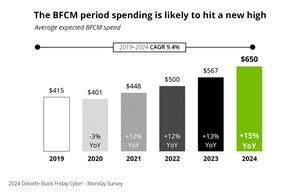NEW YORK, May 13, 2014 /PRNewswire/ -- The world's 75 largest luxury goods companies generated luxury goods sales of $171.8 billion through the end of last fiscal year (fiscal years ended through June 2013) despite a slowdown in the global economy. The average size of the Top 75 companies was $2.3 billion in luxury goods sales. This is according to the inaugural Global Powers of Luxury Goods report issued by Deloitte Touche Tohmatsu Limited (Deloitte Global).
The report identifies the largest luxury goods companies around the world—with LVMH ranking No. 1. It also provides an outlook for the leading luxury goods economies, insights for mergers and acquisitions (M&A) activity in the sector, and discusses the major trends affecting luxury goods companies including the retail and ecommerce operations of the largest 75 luxury goods companies.
"Despite operating in a troubled economic environment, luxury goods companies fared better than consumer product companies and global economies generally. For the remainder of this year, we expect growth in developed economies to pick up speed while significant risks in emerging markets remain," said Ira Kalish, chief economist, Deloitte Global. "Overall performance of the luxury sector will depend not only on economic growth, but on factors such as volume of travel, protection of intellectual property, consumer propensity to save, and changing income distribution."
Regional trends
The report focuses on the high concentration of luxury goods companies headquartered in France, Italy, Spain, Switzerland, the United Kingdom and the United States. These six countries represented nearly 87 percent of the Top 75 luxury goods companies and accounted for more than 90 percent of global luxury goods sales in 2012. France, Italy, and Switzerland achieved strong composite luxury sales growth in 2012, with France and Switzerland outpacing the 12.6 percent composite growth for the Top 75 at 19.4 percent and 14.8 percent, respectively. Italian luxury goods companies grew in tandem with the Top 75 at 12.4 percent. Countries trailing the Top 75 composite were Spain, the United Kingdom and the United States, with the United States having the smallest growth at just 5.6 percent.
"In the U.S., luxury goods should benefit from both domestic consumers and international travelers," said Alison Paul, vice chairman and U.S. Retail & Distribution leader, Deloitte LLP. "A broader product selection and price advantage compared to travelers' home countries makes the U.S. an attractive luxury market for international tourists, which include an expanding middle and upper income groups from emerging markets. Here in the U.S., an increasingly more positive outlook is a result of income growth among higher-income households and the seeming wealth effect of the stock market's recent gains."
Key drivers of M&A activity in the luxury goods sector
Globalization – Growth of wealthy and upper middle class consumers in emerging markets has been the biggest driver of M&A activity in the luxury and premium goods space in recent years. Asia Pacific, Latin America, and the Middle East and Africa accounted for a combined 19 percent of the luxury market in 2013 and the regions are projected to grow to 25 percent in 2025, according to Euromonitor.
Value chain integration – Luxury goods companies keep tight control over all aspects of business from product design and sourcing of raw materials to manufacturing, marketing, and distribution. Ownership of all aspects of the value chain for the company's product(s) helps ensure that quality and service can be maintained, thus protecting brand heritage. As a result, vertical integration has become another important driver of M&A activity in the luxury goods sector.
Consolidation as a growth strategy – Industry consolidation is another factor driving M&A activity, with the consolidators taking a number of different forms. The large luxury conglomerates operate in diverse subsectors, the common denominator being a broad expertise in luxury including an intimate understanding of the luxury consumer. Seasoned investment firms are also contributing to the greater consolidation of luxury brands into a smaller number of holding companies or groups. All of these consolidators are seeking scalable brands, including distressed or underperforming businesses that simply do not have the experience, knowledge, or resources to manage ever-expanding operations.
About the Global Powers of Luxury Goods report
The Global Powers of Luxury Goods report is focused on four broad categories of luxury goods: designer apparel (ready-to-wear), handbags and accessories, fine jewelry and watches, and cosmetics and fragrances. The report excludes the luxury categories of autos, travel and leisure services, boating and yachts, fine art and collectables, and fine wines and spirits.
About Deloitte
Deloitte refers to one or more of Deloitte Touche Tohmatsu Limited, a U.K. private company limited by guarantee ("DTTL"), its network of member firms, and their related entities. DTTL and each of its member firms are legally separate and independent entities. DTTL (also referred to as "Deloitte Global") does not provide services to clients. Please see www.deloitte.com/about for a more detailed description of DTTL and its member firms.
Deloitte provides audit, tax, consulting, and financial advisory services to public and private clients spanning multiple industries. With a globally connected network of member firms in more than 150 countries and territories, Deloitte brings world-class capabilities and high-quality service to clients, delivering the insights they need to address their most complex business challenges. Deloitte's more than 200,000 professionals are committed to becoming the standard of excellence.
Logo - http://photos.prnewswire.com/prnh/20120803/MM52028LOGO-a
SOURCE Deloitte
WANT YOUR COMPANY'S NEWS FEATURED ON PRNEWSWIRE.COM?
Newsrooms &
Influencers
Digital Media
Outlets
Journalists
Opted In




Share this article